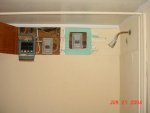shujath36
Member
- Location
- Saudi Arabia
A new customer came to me and said that his contractor laid the electrical conduits on the slab all directing to a toilet. That is he made the distribution board in toilet literally. All the laying conduits work is finished and now the customer need any other alternative in the present situation. He don't want to roll back the installations done. So is there is any way out so that the control panel going in toilet can be turned in right way without changing the conduits already installed on the slab
Sent from my SM-N9005 using Tapatalk
Sent from my SM-N9005 using Tapatalk


